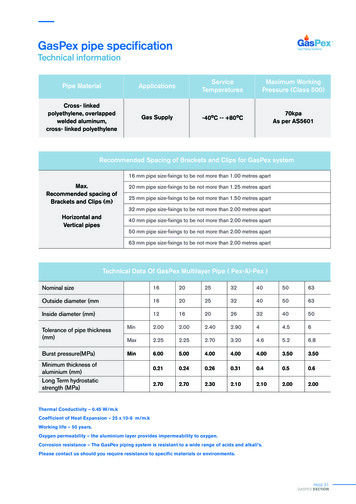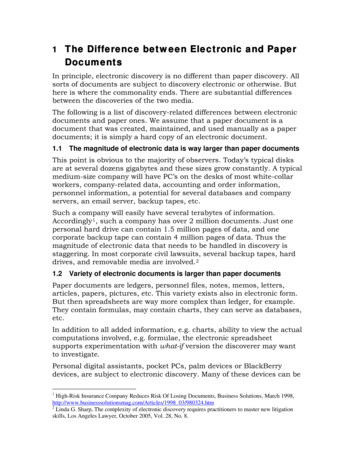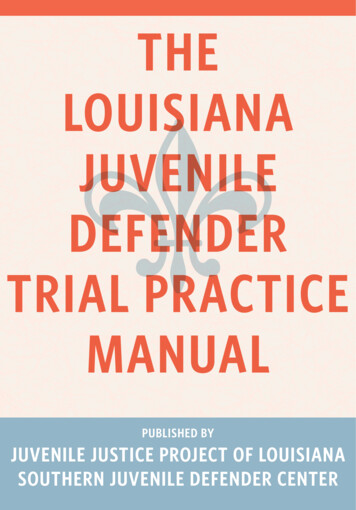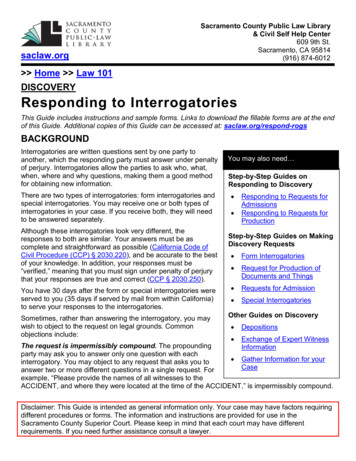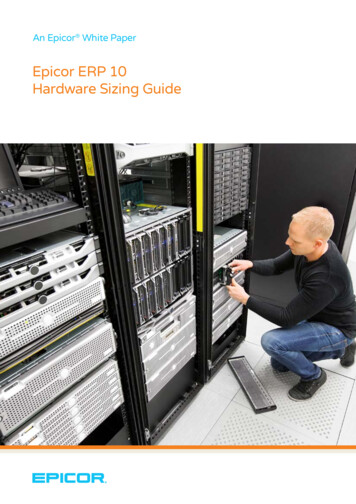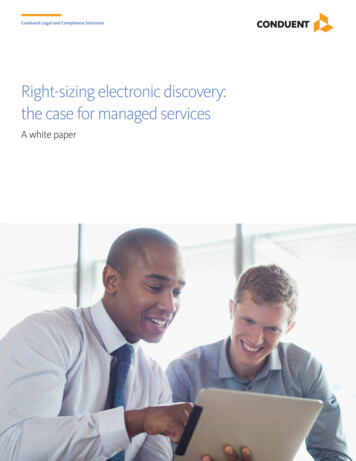
Transcription
Conduent Legal and Compliance SolutionsRight-sizing electronic discovery:the case for managed servicesA white paper
Conduent Legal and Compliance SolutionsToday, eDiscovery models are shifting as corporations re-evaluate the level of responsibilityand internal investment they are willing tomake, along with the level of control they wantIn an effort to “right-size” eDiscovery, corporations andlaw firms are debating the optimal way to manageelectronic discovery deployment within their organizations.Traditionally, corporations trusted their numerous outsidelaw firms to manage their eDiscovery functions, who inturn outsourced some processes to eDiscovery serviceproviders. The decentralization resulting from this modelhad the unintended consequences of building silos aroundcertain processes, maintaining repetitive (and sometimesoverlapping) functions, technology and resources, andmaking standardization (and budgeting) across matters andentire litigation portfolios difficult.to exercise over eDiscovery processes.Today, eDiscovery models are shifting as corporations re-evaluate the level of responsibility and internal investment they are willing to make, along with the level of controlthey want to exercise over eDiscovery processes. There are a variety of feasible optionsorganizations are now adopting, with models ranging from bringing eDiscovery entirelyin-house to, at the other end of the spectrum, fully outsourcing eDiscovery tasks to aneDiscovery service provider (while still driving strategy). Most organizations however,find the best approach lies somewhere in between — bringing certain activities in-houseand outsourcing others based on careful consideration of their needs, strengths andlong-term goals.As organizations increasingly keep processes in-house that are part of their own competencies, and collaborate with service providers on parts of the process that make sensefrom a budget, operational and risk perspective, the managed services model is increasingly a viable way to manage discovery.An overview of the optionsInsourcing: bringing eDiscovery processes in-houseOne approach is to bring the infrastructure, processes and people in-house for the broadspectrum of eDiscovery tasks, from preservation and legal hold to collections, dataprocessing, early case assessment, document review and production. The technologyitself may be a single, integrated tool or multiple applications licensed from a variety ofvendors, but the key is deploying technology that can be leveraged along with processes,staff and expertise to manage all processes internally. Such an approach provides costpredictability of the technology, and allows the organization to effectively control theprocess. Some organizations also find that work may get done faster (specifically startedfaster), since there is no third-party layer to work through.Moreover, organizations can leverage in-house knowledge and expertise on their dataand systems. For example, since upstream activities, such as preservation, legal hold and
Conduent Legal and Compliance Solutionscollections, are part of larger IT-driven business processes, these processes are oftenmore suited for internal management, with oversight from outside counsel and reliance—as needed—on certified eDiscovery consultants. Furthermore, bringing eDiscovery in-house allows organizations to maintain control over the technology and own alloperational processes and data handling activities behind their firewalls. This is ideal forcertain types of litigation, such as cross-border matters or internal investigations, wheredata often must remain on site.However, there can be a significant cost and risk attached to bringing all electronicdiscovery in-house. Organizations must continually consider a number of different andever-evolving tools required to manage each part of the process. In many cases, organizations are looking to platforms that integrate all functionality in a single product (i.e.,collections, processing, advanced analytics, review and production) to eliminate the needto invest in, integrate and manage multiple applications to manage disparate parts ofthe process. However, even fully integrated platforms require dedicated IT and legal staffto operate them, and also must address the challenges of scalability and impact on theorganization’s IT infrastructure.Custom managed services: partial outsourcing in a dedicated environmentOrganizations seeking to avoid the capital and operational expenditures and burdensassociated with maintaining and scaling infrastructure in-house—but that still want tomaintain control over the eDiscovery application and data management processes—canopt for third-party hosting of the infrastructure in a dedicated environment. Oftencalled managed hosting, this managed services model gives organizations the flexibilityto leverage their own staff to manage the application, the process and their datathemselves, with the hardware and software residing within the service provider’sprivate cloud.Beyond outsourcing the infrastructure, the organization can access—on a customizedbasis—the services it needs to fill gaps in existing technology, processes or resources. Forexample, processing and managing a large, multi-terabyte matter can present challengesto any organization. If an organization knows it does not have the capabilities to processlarge matters, it can outsource the processing and hosting for matters of or over that sizeto the service provider that can perform the work outside of the dedicated environment.Many organizations are uncomfortable about having their data managed and storedby an outside vendor due to security, privacy and business continuity concerns. Thismodel has the benefit of allowing lawyers and their IT staff to maintain stringent securityobligations by partnering with a service provider that has extensive data center securitycertifications and protocols.Comprehensive managed services: complete outsourcingIn a comprehensive managed services model, organizations outsource a substantial partof the eDiscovery process. The data management infrastructure, like the custom managed services model, is typically managed through a service provider’s private cloud ina secure environment. The services include comprehensive supporting eDiscovery datamanagement activities, such as data filtering, processing, analytics, review management,production and project management services—and even proactive compliance measuresand data analysis. The work is performed by the service provider utilizing their resources,but it is done in an environment directed by the organization.
Conduent Legal and Compliance SolutionsOne of the greatest benefits of a comprehensive managed services model is greater costpredictability and the control it affords to the organization. Services are often renderedusing innovative pricing arrangements as part of a multi-year, single provider relationship.Retainer-based arrangements, buoyed by service level agreements (SLAs) for performance, help smooth the unpredictable spikes in spend created by the transactionalnature of legal work and can ensure quality work.A managed service provider fills gaps intechnical and process resources quickly, whilereplicating and standardizing processes acrossan organization’s litigation portfolio, whichimproves efficiencies and defensibility.Moreover, service providers have an expertise and resources that are often beyond thescope of a typical organization. These relationships create a partnership and the servicepartner gains essential knowledge of corporate business activities and infrastructure.In turn, the service provider can better apply this expertise to fill the gaps in an organization’s resources and expertise, especially on topics such as data acquisition andcollections strategy (under the direction of outside counsel), strategic search, technologyassisted review (TAR) consulting, analytical services to maximize information from thedata set and managed review.An added benefit of comprehensive managed services is the facilitation of more standardized data management activities and processes across all matters, creating moreefficient, transparent and defensible processes.This approach can also be flexible and customized to fit an organization’s needs. Someorganizations—especially ones with large recurring litigation portfolios—may decideto bring hosting in-house to realize economies of scale while utilizing their partner fordata processing and other services. Others may only bring technology (and resources)in-house for processing and hosting of small, day-to-day matters (such as internal investigations or proactive upstream activities such as early case assessment and compliance),and then completely outsource all processing and hosting for burst capacity needs andmatters that exceed a certain volume.Managed review is another area that can be filled by a service provider, which can helpdrive standardization and cost control across an organization’s litigation portfolio, as wellas ensure the transfer of knowledge from project to project regardless of which outsidecounsel may be engaged in any particular project.Benefits of a managed services approachLeveraging managed services—whether choosing to outsource the infrastructure andcustomize supporting services based on the needs of the organization, or taking a comprehensive managed services approach—provides a number of distinct benefits.In addition to allowing the organization to drive the strategy but outsource some (or all)operational tasks, benefits include the following:Greater budget predictability and cost management. Managed service providers candrive innovative fee arrangements that provide transparency within the organization,budget predictability and better cost management across matters. Organizations canalso negotiate favourable and innovative agreement terms as part of long-term singlevendor contracts.
Conduent Legal and Compliance SolutionsEfficiency and defensibility. A managed service provider fills gaps in technical and processresources quickly, while replicating and standardizing processes across an organization’slitigation portfolio, which improves efficiencies and defensibility.Scalability. Managed service providers deliver technology services as a core competency,and can scale up as necessary, allowing clients to rely on the service provider’s technology infrastructure without building and maintaining their own infrastructure. This freesthe organization from fixed investments in hardware and software. Furthermore, serviceproviders can staff up and down on-demand for their clients to handle peaks and valleysin caseload.Security. Since security is part of the core service, managed service providers bring adepth of knowledge and focus on security issues and constantly emerging threats—managing security at the physical, application and end user levels. This is an especiallyimportant consideration for those who deal with client confidentiality, IP and otherproprietary information.Access to advanced technology. More often than not, rapid IT-enabled innovation ineDiscovery is not a core strength of an organization. Managed service providers typicallyhave access to technology (if not their own proprietary technology), that they can upgrade, enhance and roll out to organizations seamlessly via the cloud at no cost—such asTAR, visualization tools and other advanced analytics that help organizations reduce costand time spent on discovery.Flexibility. Managed services also offer the organization flexibility and the ability to adaptto its needs, providing services and experts to fill gaps in infrastructure, resources andexpertise, on an on-going or as-needed basis.Evaluation criteriaIn addition to understanding an organization’s core competencies, additional factorscome into play in determining the right balance of insourcing and outsourcing.All organizations should weigh the following factors: The organization’s litigation profile—i.e., the number and level of complexity of casestypically being handled at any given time, as well as expectations about future litigation The organization’s willingness and interest to invest in eDiscovery hardware, softwareand staff (along with the appetite to continually reinvest as newer, more advanced toolsare brought to market) Overall IT architecture strategy, including attitudes toward data center consolidation,cloud computing and outsourcing Current resources, including departmental structure, depth and breadth of expertise Geographic issues, such as firewall concerns, the number of locations the company has,technology capabilities and IT team experience Specific security concerns and capabilities Cultural fit and how well each approach meshes with the organization’s structureand hierarchy
Conduent Legal and Compliance SolutionsIn-house counsel have an additional set of considerations: What kind of cost predictability and cost management each approach achieves The level of control the company desires How much risk the company is willing to shoulder Pricing considerations and which model best aligns with the company’s needs Which weaknesses and gaps exist in technology and/or resources, and how particularapproaches will most effectively address thoseLaw firms specifically should consider: Whether an eDiscovery offering—beyond eDiscovery law—is or should be a dedicatedprofit center, simply part of the client offering or as an oversight role How the different approaches will impact profits per partnerOnce an organization has determined whichprocesses to keep in-house and which tooutsource, the next step involves evaluatingand narrowing the pool of potential managedservice providers. How the model will provide the cost predictability and savings that their corporateclients are increasingly demanding How much risk the law firm is willing to assume Which model will enhance or harm the firm’s competitiveness compared to other lawfirms and eDiscovery service providersConsiderations in selecting a managed service providerOnce an organization has determined which processes to keep in-house and which tooutsource, the next step involves evaluating and narrowing the pool of potential managed service providers. Legal teams should consider: Track record: The service provider should have solid experience and expertise across awide range of eDiscovery processes, along with deep bench strength. Flexible technology deployment options: Technology that can be accessed via a cloudbased hosted model or installed on premises offers more flexibility to the organizationthan a “one-size-fits-all” approach. For example, some organizations may wish to installthe technology in-house to manage day-to-day matters or upstream processes, andmigrate larger matters to the provider’s cloud for processing and hosting. Flexible pricing: Fee structures should provide transparency, control, predictability andvisibility throughout the process while meeting the organization’s needs — i.e., basedon hourly, volume, subscription, tiered discount, fixed fee, alternative fee, retainer andother models. For software licence fees, a software licence model that offers concurrentand unlimited usage allows an organization to scale users, data volume and the numberof matters without investing in additional licences. Flexible staffing: Staffing options should allow organizations to fill gaps remotely, on siteor a combination of both on an on-demand basis to maximize efficiencies in resourcesand costs. Proprietary technology: Software that is developed by the managed service provideroften means deeper product expertise and more agile responsiveness to client needswith respect to the technology.
Conduent Legal and Compliance Solutions Security protocols and certifications: Areas to look for include ISO 27001 certification,security tiers at the physical location, application and user levels, primary and backupdata centers, 24/7 active monitoring, three-tier data redundancy, extensive disasterrecovery and business continuity planning. The ability to handle private, sensitive and/or confidential information: This includesboth data handling processes and procedures and functionality in the application itselfto identify and automatically protect sensitive data. Technical and process management: The managed service provider should have reliableand repeatable methods for managing the entire eDiscovery lifecycle. Scalability: The provider should have the capacity to process and host large amounts ofdata on-demand. Global presence: The provider should be able to handle projects of any scale, languageand international complexity, with data centers that offer localized support.Managed service providers should also have well-defined plans for the deployment, inwhatever form it takes. That plan should include, at a minimum: detailed information onthe project rollout and management; a staffing plan; training programmes; user provisioning; and, proven workflows that are documented. This level of detail should alsoextend to the hardware and software capacity and contract termination.For most organizations, outsourcing of some processes as part of a managed servicesmodel increasingly makes sense. However, organizations must conduct research, understand their own needs and carefully vet potential service providers to maximize resources and results. By doing so, they can maintain flexibility, control and cost predictabilitywhile focusing on their core businesses.For more information on Conduent Legal and Compliance Solutions,visit us at: www.conduent.com/legalsolutions, or call 844.ONE.CNDTConduent Legal and Compliance Solutions (“Conduent”) is not authorized to practice law, and neither offers legal advice norprovides legal services in any jurisdiction. The services offered by Conduent are limited to the non-legal, administrative aspectsof document review and discovery projects. Conduent provides such services solely at the direction and under the supervision ofits clients’ authorized legal counsel. 2017 Conduent, Inc. All rights reserved. Conduent and Conduent Agile Star are trademarks of Conduent, Inc. and/or itssubsidiaries in the United States and/or other countries. BR1699
Comprehensive managed services: complete outsourcing In a comprehensive managed services model, organizations outsource a substantial part of the eDiscovery process. The data management infrastructure, like the custom man-aged services model, is typically managed through a service provider's private cloud in a secure environment.



